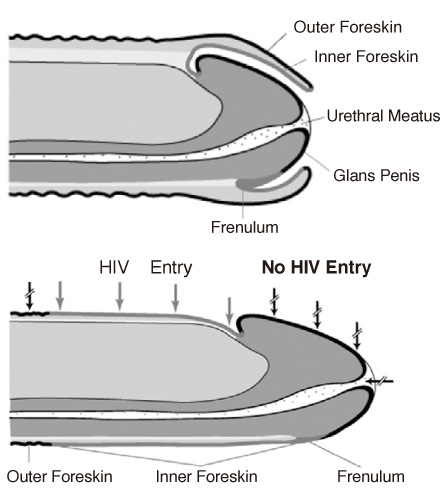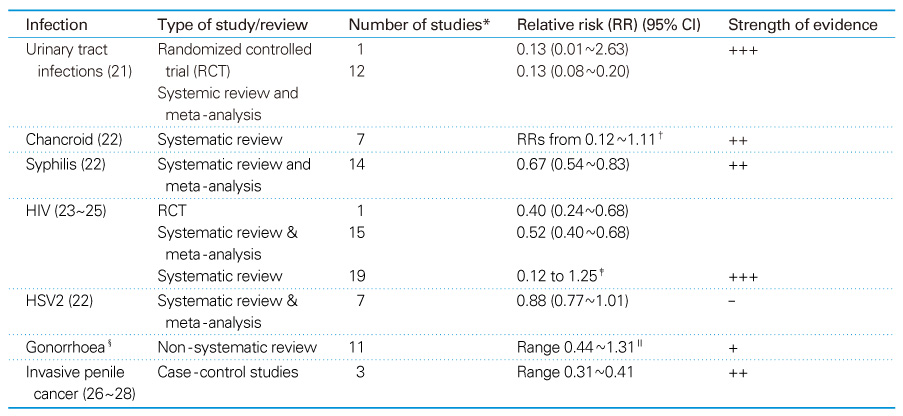1. Dunsmuir WD, Gordon EM. The history of circumcision. Br J Urol 1999;83:1-12.
2. Alanis MC, Lucidi RS. Neonatal circumcision: a review of the world's oldest and most controversial operation. Obstet gynecol 2004;59:379-395.
3. Kim DS, Lee JY, Pang MG. Male circumcision: a South Korean perspective. BJU Int 1999;83:28-33.
4. Lee SD, Park E, Choe BM. Parental concerns on the circumcision for elementary school boys: a questionnaire study. J Korean Med Sci 2003;18:73-79.
5. Oh SJ, Kim KD, Kim KM, Kim KS, Kim KK, Kim JS. Knowledge and attitudes of Korean parents towards their son's circumcision: a nationwide questionnaire study. BJU Int 2002;89:426-432.
6. Gairdner D. The fate of the foreskin. A study of circumcision. Br Med J 1949;2:1433-1437.
7. Lindhagen T. Topical clobetasol propionate compared with placebo in the treatment of unretractable foreskin. Eur J Surg 1996;162:969-972.
8. Harkarvy KL. The circumcision debate (letter). Pediatrics 1987;79:649-650.
9. Wiswell TE, Hachey WE. Urinary tract infections and the uncircumsied state: an update. Clin Pediatr 1993;32:130-134.
10. Lander J, Brady-Fryer B, Metcalfe JB, Nazarali S, Muttitt S. Comparision of ring block, dorsal penile nerve block, and topical anesthesia for neonatal circumcision: a randomized clinical trial. JAMA 1997;278:2157-2162.
12. Fergusson DM, Lawton JM, Shannon FT. Neonatal circumcision and penile problems: an 8-year longitudinal study. Pediatrics 1988;81:537-554.
18. Ryo SB, Kim KW, Kang TW, Min KD, Kwon DD, Oh BR. Study on consciousness of Korean adults for circumcision. Korean J Urol 2003;44:561-568.
19. KU JH, Kim ME, Lee NK, Park YH. Circumcision practice patterns in South Korea: community based survey. Sex Trasm Infect 2003;79:65-67.
20. OH SJ, Kim T, Lim DJ, Choi H. Knowledge of and attitude towords circumcision of adult Korean males by age. Acta Paediatr 2004;93:1530-1534.
21. Singh-Grewal D, Macdessi J, Craig J. Circumcision for the prevention of urinary tract infection in boys: a systemic review of randomized trials and observational studies. Arch Dis Child 2005;90:853-858.
22. Weiss HA, Thomas SL, Munabi SK, Hayes RJ. Male circumcision and risk of syphilis, chancroid, and genital herpes: a systematic review and meta-analysis. Sex Transm Infect 2006;82:101-109.
23. Auvert B, Taljaard D, Lagarde E, Sobngwi-Tambekou J, Sitta R, Puren A. Randomized, controlled intervention trial of male circumcision for reduction of HIV infection risk: the ANRS 1265 Trial. PLoS Med 2005;2:e298.
24. Weiss HA, Quigley MA, Hayes RJ. Male circumcision and risk of HIV infection in sub -Saharan Africa: a systemic review and meta-analysis. AIDS 2000;14:2361-2370.
25. Siegfried N, Muller M, Deeks J, Volmink J, Egger M, Low N, Walker S, Williamson P. HIV and male circumcision-a systematic review with assessment of the quality of studies. Lancet Infect Dis 2005;5:165-173.
26. Daling JR, Madeleine MM, Johnson LG, Schwartz SM, Shera KA, Wurscher MA, Carter JJ, Porter PL, Galloway DA, McDougall JK, Krieger JN. Penile cancer: importance of circumcision, human papillomavirus and smoking in in situ and invasive disease. Int J cancer 2005;116:606-616.
27. Maden C, Sherman KJ, Beckmann AM, Hislop TG, Teh CZ, Ashley RL. History of circumcision, medical conditions, and sexual activity and risk of penile cancer. J Natl Cancer Inst 1993;85:19-24.
28. Tseng HF, Morgenstern H, Mack T, Peters RK. Risk factors for penile cancer: results of a population-based case-control study in Los Angeles County (United States). Cancer Causes Control 2001;12:267-277.
29. Hutchinson J. On the influence of circumcision in preventing syphilis. Med Times Gazette 1855;32:542-543.
30. Parker JD, Banatvala JE. Herpes genitalis; clinical and virological studies. Br J Vener Dis 1967;43:212-216.
31. Hand EA. Circumcision and venereal disease. Arch Dermatol Syphilol 1949;60:341-346.
32. Moses S, Bailey RC, Ronald AR. Male circumcision: assessment of health benefits and risks. Sex Transm Infect 1998;74:368-373.
33. Van Howe RS. Does circumcision influence sexually transmitted diseases?: a literature review BJU Int 1999;83:52-62.
34. American Academy of Pediatrics. Circumcision policy statement. Task Force on Circumcision. Pediatrics 1999;103:686-693.
35. Wilson RA. Circumcision and venereal disease. Can Med Assoc J 1947;56:54-56.
36. Smith GL, Greenup R, Takafuji ET. Circumcision as a risk factor for urethritis in racial groups. Am J Public Health 1987;77:452-454.
37. Laumann EO, Masi CM, Zuckerman EW. Circumcision in the United States: prevalence, prophylactic effects, and sexual practice. JAMA 1997;277:1052-1057.
38. Fergusson DM, Boden JM, Horwood LJ. Circumcision status and risk of sexually transmitted infection in young adult males: an analysis of a longitudinal birth cohort. Pediatrics 2006;118:1971-1977.
39. Dickson NP, van Roode T, Herbison P, Paul C. Circumcision and risk of sexually transmitted infections in a birth cohort. J Pediatr 2008;152:383-387.
40. Learman LA. Neonatal circumcision: a dispassionate analysis. Clin Obstet Gynecol 1999;42:849.
41. Collins S, Upshaw J, Rutchik S, Ohannessian C, Ortenberg J, Albertsen P. Effects of circumcision on male sexual function: dedunking a myth? J Urol 2002;167:2111-2112.
42. Laumann EO, Masi CM, Zuckerman EW. Circumcision in the United states: prevalence, prophylactic effects, and sexual practive. JAMA 1997;277:1052-1057.
43. Kim DS, Pang MG. The effect of male circumcision on sexuality. BJU int 2006;18:1-4.
44. Spira AI, Marx PA, Patterson BK, Mahoney J, Koup RA, Wolinsky SM. Cellular targets of infection and route of viral dissemination after an intravaginal inoculation of simian immunodeficiency virus into rhesus macaques. J Exp Med 1996;183:215-225.
45. Miller CJ. Localization of simian immunodeficiency virus-infected cells in the genital tract of male and female rhesus macaques. J Reprod Immunol 1998;41:331-339.
46. Hussain LA, Lehner T. Comparative investigation of Langerhans cells and potential receptors for HIV in oral, genitourinary and rectal epithelia. Immunology 1995;85:475-484.
47. Joint United Nations Programme on HIV/AIDS. The HIV/AIDS situation in mid 1996: global and regional highlights 1996;Geneva: United Nations. UNAIDS fact sheet 1.
48. McCoombe SG, Short RV. Potential HIV-1 target cells in the human penis. AIDS 2006;20:1491-1495.
49. Fleming DT, Wasserheit JN. From epidemiological synergy to public health policy and practice: the contribution of other sexually transmitted diseases to sexual transmission of HIV infection. Sex Transm Infect 1999;75:3-17.
51. Bailey RC, Moses S, Parker CB, Agot K, Maclean I, Krieger JN. Male circumcision for HIV prevention in young men in Kisumu, Kenya: a randomised controlled trial. Lancet 2007;369:643-656.
52. Gray RH, Kigozi G, Serwadda D, Makumbi F, Watya S, Nalugoda F. Male circumcision for HIV prevention in men in Rakai, Uganda: a randomised trial. Lancet 2007;369:657-666.
55. Grulich AE, Hendry O, Clark E, Kippax S, Kaldor JM. Circumcision and male-to-male sexual transmission of HIV. AIDS 2001;15:1188-1189.
56. John-Stewart GC, Nduati RW, Rousseau CM, Mbori-Ngacha DA, Richardson BA, Rainwater S. Subtype C Is associated with increased vaginal shedding of HIV-1. J Infect Dis 2005;192:492-496.
57. Buchbinder SP, Vittinghoff E, Heagerty PJ, Celum CL, Seage GR 3rd, Judson FN. Sexual risk, nitrite inhalant use, and lack of circumcision associated with HIV seroconversion in men who have sex with men in the United States. J Acquir Immune Defic Syndr 2005;39:82-89.
58. Warner L, Ghanem KG, Newman D, Macaluso M, Erbelding E. Male circumcision and risk of HIV infection among heterosexual men attending Baltimore STD clinics: an evaluation of clinic-based data. Proceedings of the 2006 National STD prevention conference 2006;Jacksonville, Florida: 326.
60. Kelly R, Kiwanuka N, Wawer MJ, Serwadda D, Sewankambo NK, Wabwire-Mangen F. Age of circumcision and risk of prevalent HIV infection in rural Uganda. AIDS 1999;13:399-405.










